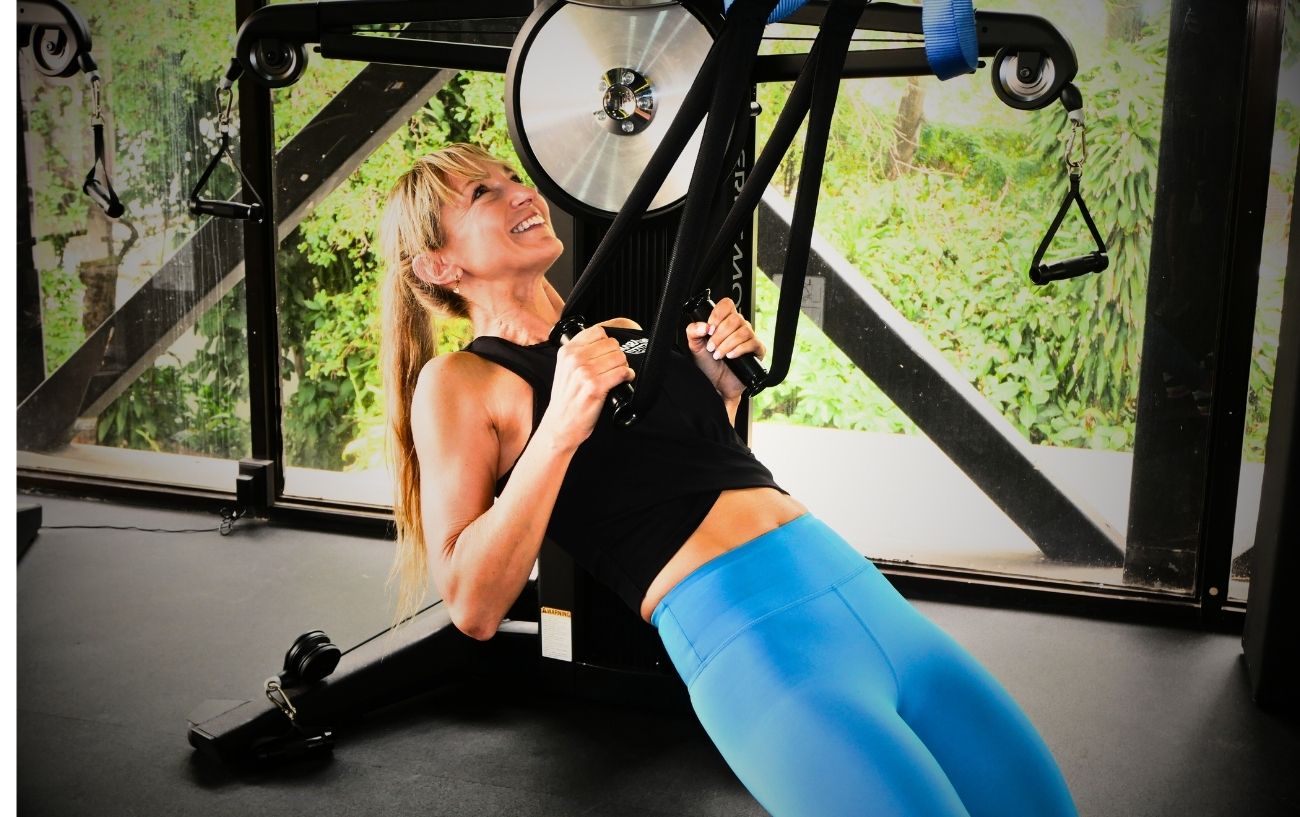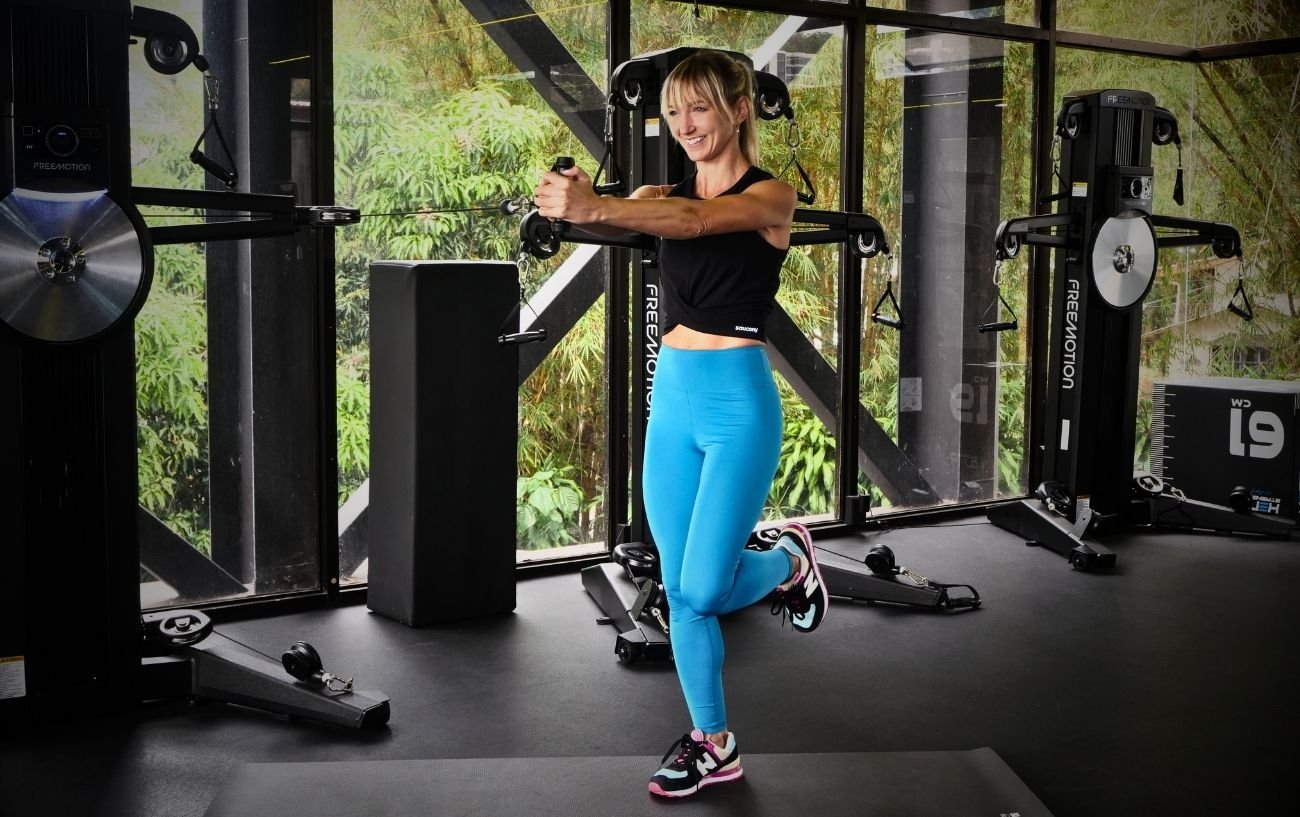Including strength training in your weekly routine is important for being a well-rounded, strong athlete and runner, staying injury-free, and performing at your best in your training sessions and races.
In this guide, we have created a strength training program for runners designed to support your needs as an athlete, improve performance, and decrease the risk of injury.
We will share some of the best exercises for you to include in your strength training plan for runners and provide step-by-step instructions and videos so that you can perform each one properly.

The Ultimate Strength Training Plan For Runners
This strength training for runners plan can be modified, either regressed for beginners or progressed for more advanced athletes, according to your fitness level and individual needs.
Be sure you warm up with 10-15 minutes of light cardio or cross training before you begin this workout.
Let’s get to our full-body workout to improve our running performance, prevent injury, and build strength.
#1: Push-Ups
Although runners often focus on lower-body exercises for runners in their strength training routines, it is also important to include upper-body strength exercises.
Having a powerful arm swing and excellent muscular endurance in your arms will help improve your cadence and prevent the breakdown of your running form during long workouts and races.
Better running form leads to better running economy.
Here is how to do a basic push-up:
- Get into the standard push-up position with your hands slightly wider than shoulder-width apart and your toes on the floor. Your body should be in a straight line from your head to your heels. Make sure that your butt is not up in the air or that your back is swayed with your hips too low down.
- Bend your elbows to lower your chest to the floor.
- Pause briefly and press through your palms to lift your body back up to the starting position. Make sure to keep your core and glutes engaged.
- Complete 10 to 25 reps.
Beginners can modify this exercise by performing to push up against a wall or elevated surface such as a desk or table. You can also drop your knees to the floor instead of your feet.
As you get stronger, progress the basic bodyweight push-up by slowing down the eccentric (lowering portion) and adding a pause or hold at the bottom position for 5 to 20 seconds.
Gradually increase the length of time for each isometric hold as well as the number of reps you do.
#2: Step-Ups With Overhead Presses
Step-ups are an excellent exercise to include in a strength training plan for runners because the unilateral movement replicates the muscular demands of uphill running and helps build functional strength and power.
Unilateral resistance training exercises can also help prevent muscle imbalances and aid in injury prevention.
Adding the overhead press component makes this a multi-joint, compound exercise that works many of the major muscle groups in the body while also activating and working core strength.
Use a heavy enough weight to be challenging but manageable for 8 to 10 reps per side.
Here’s how to do it:
- Stand facing a bench, box, or step roughly knee height or slightly lower. Relax your left arm at your side, and hold a dumbbell in your right hand at shoulder height.
- Inhale, engaging your core and glutes as you step up onto the box with your right foot, pressing the dumbbell straight over your head as you step up.
- Bring your left leg up so that you are standing on top of the box.
- Continue to face forward as you step your right foot back down behind you onto the floor, and then your left foot, and then return the weight back down to shoulder height.
- Continue leading with the right foot for 8-10 reps, then switch sides.
#3: Suspended Rows
Rows are a staple exercise in weight training workouts for runners because the movement targets your back, upper body, and core.
Although many basic strength training workouts for runners just incorporate bent-over rows with dumbbells, doing suspended bodyweight rows is an excellent substitution because it increases the demand on your abs and biceps.
If you have suspension straps available, use those, but if not, you can use the bar on a squat rack.
The lower you position the bar or the handles of the suspension straps, the more difficult the exercise will be.
In other words, the more upright your body remains, the less challenging the movement will be, and as you drop down into more of a horizontal position, the exercise will become increasingly more difficult.
- Grab the handles of the suspension straps in each hand or place your hands on the barbell with your palms facing away from your body and your hands spaced shoulder-width apart.
- Tighten your whole body so that you are as stiff as a board or plank.
- Lean back from your heels and walk your heels forward until your body is at a 10-45 degree angle relative to the ground. Again, the further forward your feet and the more parallel you are to the floor, the harder the exercise will be.
- Your entire body should be in a straight line with your heels on the floor, your toes pointing towards the ceiling, and your gaze looking upwards. Make sure that your core is engaged and your glutes are tightened.
- Straighten your arms to drop your body down so that you are essentially in the reverse of the starting position of a push-up, and then bend your elbows and pull your body upward toward the bar or handle until your chest taps them, much like the lowered position of a push-up in reverse.
- Lower your body back down to the starting position by straightening your arms out. Remember to keep your body stiff as a board the entire time.
- Perform 12 to 15 reps.
#4: Medicine Ball Forward Lunges with Rotation
This is a good exercise to include in a strength training plan for runners because it mimics the unilateral demand of running while activating the core and incorporating challenging elements of balance, hip stability, and glute activation.
Here are the steps:
- Stand upright with your feet hip-width apart, holding the medicine ball or dumbbell between your two hands away from your body with your arms fully extended straight in front of your body.
- Step your right foot forward and drop down into a lunge, bending each knee 90° until your back knee nearly touches the floor while simultaneously rotating your trunk and arms to the right by engaging your obliques. Keep your arms straight as you rotate.
- Step back into an upright position while rotating the weight back to the starting position.
- Switch legs.
- Alternate legs, completing 12 reps per leg.
#5: Single-Leg Romanian Deadlifts
One of the best exercises to include in strength workouts for runners is the single-leg deadlift. It strengthens all of the posterior chain muscles, especially the glutes and hamstrings, which are crucial for runners.
Because it is a unilateral exercise, it also activates the core and requires tremendous balance, ankle and hip stability, and core control, all of which replicate the biomechanical and muscular demands of running.
A research study1ACE CERTIFIED • February 2018. (n.d.). https://acewebcontent.azureedge.net/February2018/ACE_HamstringsStudy.pdf conducted by ACE Fitness also demonstrated that single-leg Romanian deadlifts are one of the top three most effective hamstring weight-lifting exercises.
- Stand with good posture, placing your feet shoulder-width apart with a slight bend in your knee, arms at your side, and a dumbbell in your right hand.
- Engage your core and bring your left arm to the side of your body for balance.
- Lift your right leg off the ground as you bend your left knee (the one on your standing/support leg) about 20 degrees to activate your hamstrings and glutes.
- Hinge at your hips to bring your torso towards the floor, engaging your glutes and keeping your gaze on the floor to prevent hyperextending your neck.
- Extend your right leg behind you as a counterbalance while you reach the dumbbell in your right hand down towards your left foot.
- Engage your core and glutes to return your body upright, extending your hips until they are fully locked out. Try to keep your right foot elevated so that it does not touch back down on the ground, as this will help improve the muscular endurance of the stabilizing muscles in your hips and ankles. However, beginners can touch the leg back down when they stand upright to help them regain their balance.
- Complete 10-12 reps and then switch sides.
#6: Single-Leg Pallof Presses
This is a great anti-rotation core exercise that improves hip and ankle stability.
Here are the steps:
- Attach a resistance band with a handle to a stationary object or use a cable pulley machine with the handle at chest height.
- Position your body at a 90-degree angle from the band’s anchor point to be on the right or left side of your body. Hold the handle of the band at your sternum. You should be far enough away from the anchor point to have significant tension on the band in the starting position. Use a thicker band as you get stronger.
- Stand on one leg and press the band straight out before you. Engage your glutes, abs, and shoulders so that your arms are not pulled inward toward the band’s anchor point.
- Complete 15 slow reps and then switch sides.
#7: Bulgarian Split Squat
Split squats are great for strengthening your quads, core, and spinal extensor muscles and should definitely be a part of your strength workouts for runners.
The Bulgarian split squat elevates your rear leg, which increases the activation of your adductors, making this an excellent strength training exercise for runners.
- Stand about three feet in front of a weight bench or chair facing away, with the laces part of your rear foot on the bench behind you. Beginners can begin with just their body weight, but once you have mastered the technique, hold a dumbbell in each hand to increase the intensity of this strength training exercise.
- Your front foot should be far enough in front of your body that when you drop into a lunge, your front knee does not extend beyond your toes.
- Keeping your shoulders back and core tight, bend your front knee to drop into a split squat or static lunge position.
- Drop down until the thigh of your front leg is parallel to the ground and your knee is bent 90°. Then, press through your heel on the foot in front to return to the standing position.
- Complete 8 to 10 reps and then switch sides.

You should be using a weight heavy enough to do no more than ten repetitions. Once you can easily complete ten repetitions, increase the weight you are holding.
In this strength training for runners plan, begin with two sets of each exercise and progress to three sets as you get stronger. Use heavy weight, but not so heavy that you can not properly perform each exercise with good technique.
Beginners should start by doing this strength training program for runners twice a week. Work up to 3 times weekly if you have the interest and time in your overall training plan.
Make sure to take at least one full day of rest in between each time you do this runner’s workout.
To build power and strength, you can also add plyometric exercises to your strength training days. Check out our guide here!














Does the model doing the exercises always have to have this big blissed out grin? No one in real life who is seriously working out looks like that.
you haven’t met Katelyn then.
Thomas from Marathon Handbook